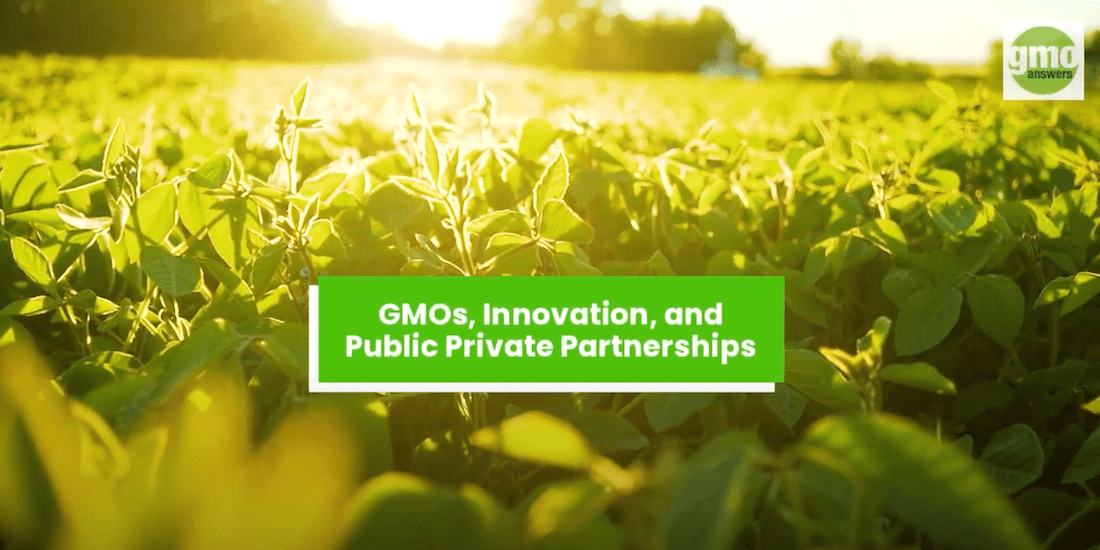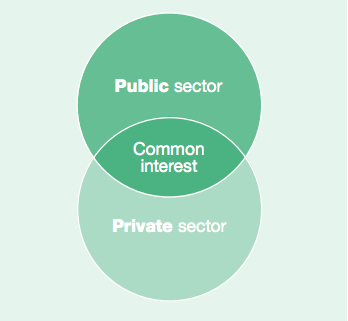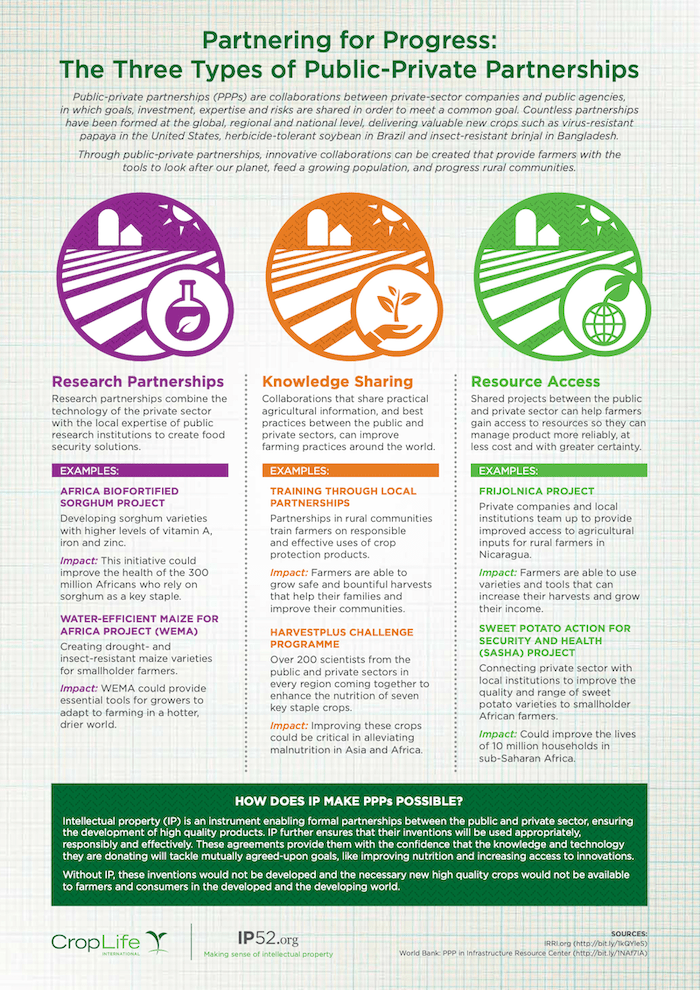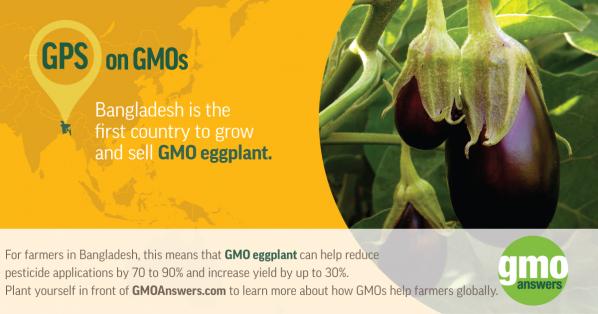Innovating GMOs through Public-Private Partnerships

One of the biggest myths about GMOs is that they are all made by the private sector. The reality is that claim is not true.
Not only are there some GMO crops on the market and currently in research and development (R&D) that are solely a result of public sector research (universities, governments, and non-profits), but there is also research being done to develop new GMOs that are the result of public-private partnerships. 
That being said, on average, GMOs take 16.5 years and $115 million in R&D before coming to market, which makes it difficult for small companies and universities to develop GMO crops on their own. The regulatory process alone can take 5 to 7 years.
As for why more GMOs aren’t produced by small firms or universities, the answer is this: The pressures and demands on public institutions continue to increase – as do the costs of research and development. It is therefore critical that the public and private sectors continue, if not accelerate, their efforts to work together to meet the challenges facing our world’s farmers. The need to innovate for mutual growth and mutual benefit has never been greater.
To meet the challenges, we need to increase public and private funding of agricultural research and increase the impact of this funding through deeper and broader collaborations between the public and private sectors and research communities. Equally important, scientific capacity, regulatory frameworks, social and research infrastructures, and effective legal frameworks and institutions need to enable collaborative projects and support the introduction of technology.
The Increasing Importance of Public-Private Partnerships
To ensure global food security, we need to continuously improve the tools and techniques available to farmers working in diverse ways and environments around the world. This involves not only developing new technologies but also adapting and applying these innovations to local needs and conditions. It also involves ensuring they can be used effectively by skilled and well-informed farmers. Neither the private nor the public sector can achieve these aims on its own. But together, they can combine and maximize the impact of their individual experiences and resources where it matters most – at the local level with our farmers around the world.
From feeding a population expected to reach $9 billion dollars by 2050 to looking after soil, water, and natural habitats, our world’s farmers face increasing challenges. What’s more, they’re under greater pressure from the changing climate and a shrinking agricultural workforce. As a result, farmers need innovative tools that improve sustainability more than ever before. Providing farmers access to tools such as GMOs as well as the knowledge and skills to use them responsibly can make a major impact on their farms.
What Makes a Successful Public-Private Partnership?
Collaborations between public and private sectors enable goals, resources, expertise, and risk to be shared, ensuring scientific innovations become valuable tools for farmers.
Successful public-private partnerships:
- Improve the efficiency of developing locally-adapted innovation.
- Enable technology to be distributed more effectively to local farmers.
- Help farmers continuously improve and make the most of sustainable agricultural practices.
- Promote the effective and responsible application of new technologies.
- Provide social and economic value to farmers and communities.
For national governments, public-private partnerships offer an efficient way to bring timely and relevant tools to local farmers, while helping to build agricultural knowledge at a local level.
For the private sector, collaboration provides an innovative approach to financial and resource needs and helps develop potential new markets. As a result, greater innovation can be put in the hands of our world’s farmers.
The public and private sectors often play different research and commercialization roles and possess a broad range of complementary abilities, resources, and expertise. To combine these elements into a successful project, partners need to consider a variety of factors.
- In Bangladesh and the Philippines, biotech brinjal (GMO eggplant) technology was donated directly to local researchers to give farmers quicker access to improved varieties that are resistant to local pests.
- A multinational team of private and public sector scientists is currently developing genetically modified (GM) bananas in Uganda with increased vitamin A, vitamin E and iron content. Banana is a major food crop in Uganda, so successful research could dramatically improve the diets of millions of people.
- Brazil’s public agricultural research corporation, Embrapa, has worked with private sector companies that have supplied genetic information used to develop an herbicide-tolerant GMO soybean that meets local growers’ specific needs.
- The BioCassava Plus project is working to improve the nutritional quality of cassava, the primary source of calories for over 250 million people in sub-Saharan Africa. Public and private sector researchers are focusing on enhancing levels of zinc, iron, protein and vitamins. They are also focusing on improving the durability of cassava once it has been harvested – vital, given the poor quality of local storage facilities.
- The Africa Biofortified Sorghum project is a public-private consortium that relies on technology, capacity building and research knowledge from the private sector. It is developing a more nutritious and easily digestible sorghum that contains increased levels of amino acids, vitamins, iron and zinc. This could improve the health of 300 million people by increasing the nutritional quality of this important dietary staple.
Agricultural innovations come from both public and private sector research and almost always involve a lot of time, resources and financial uncertainty. Research priorities for both sectors depend on a complex mix of factors, including benefits to farmers, consumers, and the environment, as well as a return on research investment.
By working together through public-private partnerships, these two sectors can pursue unique or otherwise speculative projects. They can also bring together the necessary experience, knowledge, investment, technologies and resources to address agricultural issues which may have been overlooked by a single-sector program or approach.
To learn more about GMOs, innovation and public-private partnerships, please see below:
Public-Private Partnerships – In Agriculture and Beyond
There is a common misconception that companies “buy and pay for” university research. The truth is that there is a much more ongoing, collaborative relationship between the private sector and academia. The two have been working together for over a century to explore, refine, and advance scientific ideas. The collaboration between the private sector and academic institutions exists not just in agriculture, but in other scientific fields such as healthcare, renewable energy, manufacturing and more.
In this post, we explore how companies, universities, and other entities work together to support programs to benefit the public sector through Public-Private Partnerships or PPPs.
Working Together to Help Farmers – The Benefits of Public-Private Partnerships from CropLife International
Farmers and other members of the agriculture industry are tasked with sustaining the environment while producing more food to feed an increasing global population. In order to meet these challenges, farmers need access to the best agricultural innovations available. CropLife International discusses the benefits and examples of public-private partnerships and how they are helping farmers around the world in this publication.

Public-Private Partnerships: A Vital Mechanism for Advancing Agricultural Innovation
As populations continue to grow, the world’s farmers have the formidable task of providing nutritious food for 9 billion people by 2050. Several fierce challenges still stand in their way as our world resources are under more strain than ever, whilst at the same time, more frequent and extreme weather conditions caused by climate change are affecting farmers' ability to produce enough food to meet demand. These issues are incredibly complex to solve, yet are becoming increasingly urgent. Public-private partnerships (PPPs) are one way in which expertise from different fields can be combined to reach innovative agricultural solutions. Learn more from Farming First.

